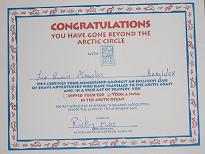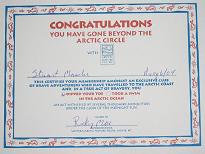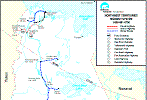Mawlers’ Big Adventure ’04:
Swimming in the Arctic - Tuktoyaktuk
Friday, 6 August 2004
|
|||
|
We sign up for a tour of Tuktoyaktuk, Northwest Territories, an Inuvialuit village/town about 180 km north of Inuvik, on the Arctic Ocean. In the summer, Tuk is only accessible by airplane from Inuvik. I guess you could canoe/walk, but it would be a long, long trip. In the winter, there is an ice road to Tuk from Inuvik, where cars, trucks, semis, etc., drive on the frozen MacKenzie river, and along the coast of the frozen Arctic Ocean. No, really. Our tour has four other people, all from British Columbia, and all apparent retirees. We have noticed on this trip that everyone seems to be early 20s and here for the summer between semesters of school because it sounded like an adventure, or retirees in RVs. There are very few people who seem to fit our demographic. But, these four are nice and we chat about the birds in the area. They are avid "birders" and have managed to see and catalog a number of birds in the area. We, on the other hand, are avid photo-takers, and we have managed to photograph a few birds, including the swans, sand-hill cranes, and a couple of ducks. We get to the airport and find that we are taking mosquito airlines (how appropriate for this area), in an airplane that has one propeller, and that has to be loaded (i.e., seating assignments) according to the size of person. Need I say that Stuart and I didn't sit together? When the pilot asked how heavy our backpacks were, I thought maybe I should have re-started that Atkins thing before now... The plane sounds like an old steam engine starting, but it gets off the ground without incident. It turns out that the flight is beautiful, and Stuart and I have our noses glued to the window taking pictures of lakes and rivers and ocean and caribou trails for the whole flight. We get a great view of pingoes, which are hills that are formed when the water from a lake seeps into a crack in the ground and freezes, expanding and pushing the ground up. There are two pingoes right in Tuk, one being 50 meters tall, the 2nd highest pingo in the world. When we land, we are met by Ricky Mac, our local tour guide. Ricky tells us that he is a native of Tuk, and that he left once and went to Hay River, but didn't like the big city and came back. Hay River is another tiny town in Northwest Territories. He's a lot of fun, and shows us around the town, pointing out how the heating and water infrastructure work, and the local landmarks.

 Part of the lure of the tour is the Arctic Ocean toe-dip or swim. Ok. Do you think I'm going all the way to the Arctic Ocean and going to stick my toe in? That would be silly (no offense, Stuart). Besides, the place Ricky takes us is shallow, only about 2-3 feet deep for 100 yards out. That keeps the water temperature pleasantly cool, but not the temperature of the ocean normally, a bone-chilling 0 degrees celcius. I leave Stuart with the camera and start to plod out into the water. It's cold, but not really terribly so, and I have actually been in colder water before, so I'm not detered. However, the current is strong, and the rocks (there's no sand here) are very slippery, so it's an effort to walk out into the water. And, it's frustrating that it's not getting any deeper. About 100 yards off shore (well out of the reach of any of my compatriots who think I'm a lunatic for even being in a bathing suit, much less being about to plunge into the Arctic Ocean), I go for it. I drop into the water, submerging. I pop up, sputtering. It's cold, of course, but the current is strong here, and that's my main concern. I struggle to regain my balance on the slippery rocks (it's too shallow to "swim"), and I can hear Stuart saying something to me. The water is murky (I don't like murky water), and I have to reach down to the bottom several times to steady myself before I can once again stand up and try to hear what he's saying. What he's saying, rather sadly, is: "Did you lose your glasses?" Sigh. One of the things that people who aren't very nearsighted often don't understand is that for the very nearsighted, taking off your glasses is something akin to taking off your arm. They aren't like clothes or accessories, they're like a body part. And, so, I didn't even consider them -- didn't even think about them -- as I plodded into fast moving, excedingly murky, inaccessible to anyone but foolhardy me water. I actually tried to "look" for my glasses for a few moments... I even looked at where I'd churned up the bottom struggling to stand up and felt around on the rocks to see if I could find them. I was bemused that I didn't really even know if they would sink or float. After a few futile moments of trying to catch a glint in the sun or a dark outline in the waves, I gave up. It really was futile. My exceedingly expensive, high-density, titanium glasses were now an offering to the Arctic Ocean. Maybe some Beluga Whale out there is seeing the world clearly for the first time tonight. I wade back to shore, and Stuart takes my hand, guiding me along the rocks. Perhaps an explanation of our vision would help. Stuart and I are like moles. We don't see well at all without our glasses. (Moles just don't see well at all.) My vision is 20/575 or so. I've been told a good way to think about that is that something (let's say a sign with lettering) that a 20/20 person can see clearly 575 ft away has to be 20 ft away for me to see it. Put another way, I can read paperback sized text clearly about 6 inches away from my eyes (nearly touching my nose) and no further. I don't see the big E on the eye chart without my glasses. And, Stuart's vision is much worse than mine, at 20/900 or so. So, negotiating small round rocks back to the van is a challenge, and I become resigned to the fact that I will see only the most basic shapes for the rest of the tour. Oh well. One woman asks me if I lost my sunglasses. I tell her no, they're my glasses glasses, and she remarks that I seem so nonchalant about it. I wonder (to myself) what she was expecting? A full-fledged tantrum? Pulling of hair and gnashing of teeth? Quiet but profound tears? I'm sad, yes. I love those glasses. And, they're brand new. And they're very expensive. And it's not likely that insurance will pay for a replacement pair. But, I have another pair in the car (because I know better than to trust myself to not break, lose, spindle, or mutilate my glasses on vacation where there is no such thing as overnight delivery), and my lovely glasses are gone. Not too much a tantrum will do about that. The tour is pretty neat, even without glasses. We visit churches in Tuk that were built in 1934 and 1938 and are still in use in the same buildings and format that they were then. We visit the ice house where people store their food in the permafrost below ground. Ricky tells us about the Polar Beach Party that Molson held in 1995, and how Metalica donated money for a community center in Tuk. He claims some of the elders in the village still listen to Metalica.
We get back to the airport, and I'm bummed about the trip back. Not being able to see a foot in front of your face means getting up close to things in the church, but there's no hope from several thousand feet up. But, I manage to take a few pictures anyway (I can actually see in the view finder of the camera what I can't see out the window). I get a blurred shot of a herd of caribou along the MacKenzie River, but I did get the shot. When we get back to Inuvik, Stuart pulls my spare pair of glasses out of the car. With a sigh of relief, I put them on. We go to a convenience store and buy something to drink, and we go back to the truck to put some things away. Unfortunately, one of the things we put away is Stuart's jacket, which contains the truck keys. We have gotten into the habit of locking the truck with the automatic door locks on the door, instead of the remote because that way it doesn't beep when it locks. As soon as we close the doors, we know what we've done. Sigh. Again. We know there is a national car rental place around the corner, so we wander over and talk to some folks there. After some waiting, they opened the truck for us, and we retrieved our keys. We have dinner at To Go's, at the suggestion of Ricky Mac, so I could try a Musk Ox burger. I don't know... It reminds me of hamburger that's been mushed together too much and is too smooth. But, overall, not bad. We retire back to our room at the Arctic Chalet and settle in to watch the sunset on our last night in Inuvik. |
|||
|
|
|||
 see it on a map |
|||
|
|
|||
|
The previous installment: |
The next installment: |
||
Back to Great White North Trip main page
Back to Mawler Home
All materials © 2004 Lea Ann Mawler & Stuart Mawler